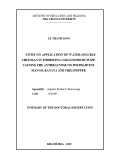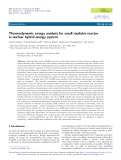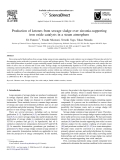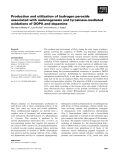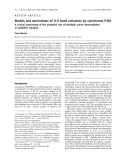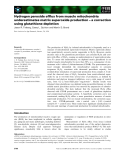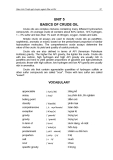
Hydrogen production
-
In recent years, the development of hydrogen as a new reliable energy source has become a trend and caught lots of attention from all over the world. Hydrogen is a fundamental element that can be produced via different processes, which can be classified into three main groups: green processes (electrolysis), carbon-treated processes (thermoconversion processes), and traditional processes (reforming processes). Hydrogen products were identified using their specific color such as green, blue, and brown hydrogen…
 15p
15p  viyamanaka
viyamanaka
 06-02-2025
06-02-2025
 4
4
 2
2
 Download
Download
-
The purpose of the dissertation: Create low molecular weight, water-soluble chitosan with antifungal ability from chitosan by the degradation method by hydrogen peroxide agent to prevent effectly the anthracnose on post-harvest fruit and vegetables (mango, banana and chili pepper)
 34p
34p  tunelove
tunelove
 11-06-2021
11-06-2021
 44
44
 3
3
 Download
Download
-
Purpose: Using the density functional method (DFT) to find out the mechanism of CO2 hydrogenation reaction, the main product, by-products, the optimal reaction path, compare and evaluate the catalytic ability of the Ni5 cluster, Ni5/MgO, and Ni5/AC.
 25p
25p  thebadguys
thebadguys
 08-06-2021
08-06-2021
 13
13
 3
3
 Download
Download
-
The paper will present background information on exergy theory; identify the core subsystems in an SMR plant coupled with storage systems in support of renewable energy and hydrogen production; perform a thermodynamic exergy analysis; determine the cost allocation among these subsystems; and calculate unit exergetic costs, unit exergoeconomic costs, and first and second law efficiencies.
 10p
10p  christabelhuynh
christabelhuynh
 30-05-2020
30-05-2020
 25
25
 1
1
 Download
Download
-
Recovering useful hydrocarbons from sewage sludge using zirconia-supporting iron oxide catalysts was investigated. Zirconia has activity for decomposing water molecules to generate active oxygen and hydrogen species.
 6p
6p  tuananhhumg
tuananhhumg
 04-11-2013
04-11-2013
 38
38
 3
3
 Download
Download
-
Human hepatitis delta (HDV) ribozyme is one of small ribozymes, such as hammerhead and hairpin ribozymes, etc. Its secondary structure shows pseudoknot structure com-posed of four stems (I to IV) and three single-stranded regions (SSrA, -B and -C). The 3D structure of 3¢-cleaved product of genomic HDV ribozyme provided extensive information about tertiary hydrogen bonding interactions between nucleotide bases, phosphate oxygens and 2¢OHs including new stem structure P1.1.
 12p
12p  tumor12
tumor12
 22-04-2013
22-04-2013
 40
40
 3
3
 Download
Download
-
The synthesis and involvement of H2O2 during the early stages of melano-genesis involving the oxidations of DOPA and dopamine (diphenolase activity) were established by two sensitive and specific electrochemical detection systems. Catalase-treated reaction mixtures showed diminished rates of H2O2 production during the autoxidation and tyrosinase-mediated oxidation of both diphenols.
 0p
0p  awards
awards
 06-04-2013
06-04-2013
 33
33
 3
3
 Download
Download
-
Cytochrome P450 enzymes promote a number of oxidative biotransformations including the hydroxylation of unacti-vated hydrocarbons.
 26p
26p  awards
awards
 05-04-2013
05-04-2013
 47
47
 7
7
 Download
Download
-
Hydrogen sulfide is a potent toxin of aerobic respiration, but also has physiological functions as a signalling molecule and as a substrate for ATP production. A mitochondrial pathway catalyzing sulfide oxidation to thio-sulfate in three consecutive reactions has been identified in rat liver as well as in the body-wall tissue of the lugworm,Arenicola marina.
 10p
10p  galaxyss3
galaxyss3
 07-03-2013
07-03-2013
 41
41
 4
4
 Download
Download
-
The production of H2O2 by isolated mitochondria is frequently used as a measure of mitochondrial superoxide formation. Matrix superoxide dismu-tase quantitatively converts matrix superoxide to H2O2. However, matrix enzymes such as the glutathione peroxidases can consume H2O2 and com-pete with efflux of H2O2 , causing an underestimation of superoxide produc-tion.
 13p
13p  mobifone23
mobifone23
 21-01-2013
21-01-2013
 47
47
 3
3
 Download
Download
-
BASICS OF CRUDE OIL Crude oils are complex mixtures containing many different hydrocarbon compounds. An average crude oil contains about 84% carbon, 14% hydrogen, 1 ÷ 3% sulfur and less than 1% each of nitrogen, oxygen, metals and salts. Simple crude oil assays are used to classify crude oils as paraffinic, naphthenic, aromatic or mixed, based on the predominant proportion of similar hydrocarbon molecules. The comprehensive crude assays determine the value of the crude: its yield and quality of useful products.
 5p
5p  vitconsieuquay
vitconsieuquay
 19-08-2011
19-08-2011
 255
255
 141
141
 Download
Download
-
Abstract A new method is presented for improving the performance of red mud as a hydrogenation catalyst (a residue from the production of alumina by the Bayer process that contains iron oxides), based on the method developed by K.C. Pratt and V. Christoverson, Fuel 61 (1982) 460. The activation method consists essentially in dissolving red mud in a mixture of aqueous hydrochloric and phosphoric acids, boiling the resulting solution, adding aqueous ammonia until pH8, and ®ltering, washing, drying and calcining the resulting precipitate. ...
 11p
11p  tudoia
tudoia
 06-04-2011
06-04-2011
 69
69
 6
6
 Download
Download
-
Abstract Red mud is a residue in the production of alumina by the Bayer process. It contains oxides of iron and titanium, and has been shown to be active in sulfided form as hydrogenation catalyst. The evolution of sulfided red mud activity and selectivity with reaction time was studied for the hydrogenation of a light fraction of an anthracene oil.
 15p
15p  tudoia
tudoia
 06-04-2011
06-04-2011
 96
96
 12
12
 Download
Download
-
Catalytic oxidation of organic compounds is an extremely important field of chemistry, spanning the range from biological oxidations to large scale industrial production of commodity chemicals. However, many of these transformations can hardly be classified as organometallic reactions, since the catalysts (often simple metal salts) and the intermediates can be rather regarded as coordination complexes than organometallic compounds.
 7p
7p  boyminsk
boyminsk
 10-06-2010
10-06-2010
 106
106
 19
19
 Download
Download
CHỦ ĐỀ BẠN MUỐN TÌM









